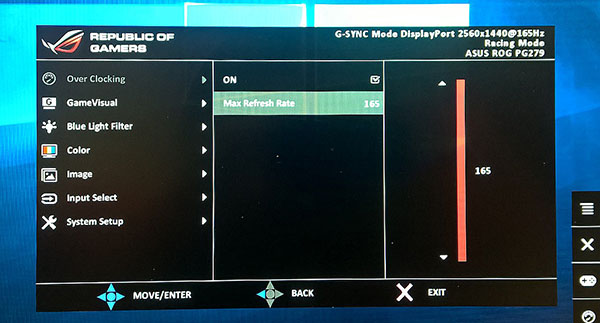What's it like to game on?
The real magic of this screen is in having a panel capable of 165Hz refresh rates using IPS-type technology. Asus doesn't manufacture its own screens and thus has to go to a third party to source appropriate panels. The historically slow response times for IPS monitors has been an obvious stumbling block for producing high refresh rates screens... though that seems to have been overcome now.
IPS in all but name
The AU Optics M270DAN02.3 Advanced Hyper-Viewing Angle (AHVA) panel has an official upper echelon spec of 144Hz, which is already considered cutting edge, and it exists on both the FreeSync (MG279Q) and G-Sync (PG279Q) models. It's not technically an IPS panel, because that trademark belongs to LG, but the characteristics of AU's AHVA are close enough for the two technologies to be interchangeable. Acer also uses this panel for its XB270HU monitor, if you were wondering.
Offering more for the G-Sync variant, Asus enables overdriving of the refresh rate, up to 165Hz, should you have a GeForce GTX 960 or better graphics card. The card needs to be fairly new, however, as a GeForce GTX 780 Ti supports a maximum of 144Hz.
This is, in effect, overclocking an already-fast display. More pertinent than the higher refresh rate is the support ranges for the respective framerate-matching technologies - the MG279Q supports 35-90Hz for AMD cards while this monitor can operate the Nvidia technology at 30-165Hz. Nvidia says there is no upper limit at which G-Sync stops working, so Asus has made the most of the limitless headroom with the PG279Q.
Interestingly, the DisplayPort 1.2a standard offers up 21.6Gbps of bandwidth, though a little less once overhead is removed. Operating an 8-bit screen at the WHQD resolution and 165Hz brings total required bandwidth to almost 20Gbps, meaning that Asus is cutting it very close in terms of breaching the official specification. Whatever the case, the screen works just fine at 165Hz.
A few more tricks
G-Sync at high refresh rates is the obvious draw here, but just like other premium monitors featuring the technology, the PG279Q can use technology called Ultra-Low Motion Blur (ULMB), stemming from the LightBoost tech introduced as part of Nvidia's stalled 3D Vision initiative.
Specifically, at high refresh rates - set to 85Hz, 100Hz or 120Hz - ULMB modulates the backlight of the monitor such that images are shown for the least time possible, achieved by overdriving the PG279Q when the frame is displayed and shutting off the backlight completely when there's no frame. By strobing the backlight in this manner, allied to high refresh rates, motion blur can be greatly reduced. High refresh rates are great, but even now, you cannot run both G-Sync and ULMB at the same time.
Controlling the OSD via a joystick makes configuration a lot simpler than on rival models. The OSD is bright, clearly laid out and provides a reasonable amount of fine-tuning for the display. The screen ships with fairly bright settings out of the box, with brightness set to 80 and contrast to 50, so we'd recommend users lower the output.
Eyes on gaming
The real meat on the PG279Q's bones is how well it renders games. We used an overclocked GeForce GTX Titan X to hammer out impressive framerates at the screen's native 2,560x1,440 resolution. We used the games in our high-end suite where the Titan X routinely scores over 60fps.
It's actually strange to see no tearing when gaming. It's become so much a part of PC gaming that it's conspicuous by its absence in a good way. Matching up frame rates and the monitor's output makes sense at the 40-60fps range, as that's where the tearing and stuttering is more keenly felt. However, if you have the silicon horsepower to run high frame rates consistently, as is the case with the Titan X, gaming feels that much more fluid.
High-refresh rate monitors have often been put forward as a solution to the visual anomalies otherwise seen, solely because any artefacts are on the screen for a shorter amount of time. The gold standard, in our opinion, is matching 100Hz-plus refresh rates up with variable-refresh technology such as G-Sync or FreeSync.
From a qualitative approach the 165Hz maximum refresh and G-Sync technology is very hard to beat, and a monitor such as the PG279Q makes a lot of sense for gamers who have super-powerful PCs. Helping that line of thinking is input latency of just 10.2ms, which is well above average for monitors of this type.
Lastly, power consumption is a tad below average. In its out-of-the-box guise, the monitor draws 41W when displaying a black screen and 50W for an all-white screen.











